Haobo Wang
CrowdAgent: Multi-Agent Managed Multi-Source Annotation System
Sep 17, 2025Abstract:High-quality annotated data is a cornerstone of modern Natural Language Processing (NLP). While recent methods begin to leverage diverse annotation sources-including Large Language Models (LLMs), Small Language Models (SLMs), and human experts-they often focus narrowly on the labeling step itself. A critical gap remains in the holistic process control required to manage these sources dynamically, addressing complex scheduling and quality-cost trade-offs in a unified manner. Inspired by real-world crowdsourcing companies, we introduce CrowdAgent, a multi-agent system that provides end-to-end process control by integrating task assignment, data annotation, and quality/cost management. It implements a novel methodology that rationally assigns tasks, enabling LLMs, SLMs, and human experts to advance synergistically in a collaborative annotation workflow. We demonstrate the effectiveness of CrowdAgent through extensive experiments on six diverse multimodal classification tasks. The source code and video demo are available at https://github.com/QMMMS/CrowdAgent.
SPA++: Generalized Graph Spectral Alignment for Versatile Domain Adaptation
Aug 07, 2025Abstract:Domain Adaptation (DA) aims to transfer knowledge from a labeled source domain to an unlabeled or sparsely labeled target domain under domain shifts. Most prior works focus on capturing the inter-domain transferability but largely overlook rich intra-domain structures, which empirically results in even worse discriminability. To tackle this tradeoff, we propose a generalized graph SPectral Alignment framework, SPA++. Its core is briefly condensed as follows: (1)-by casting the DA problem to graph primitives, it composes a coarse graph alignment mechanism with a novel spectral regularizer toward aligning the domain graphs in eigenspaces; (2)-we further develop a fine-grained neighbor-aware propagation mechanism for enhanced discriminability in the target domain; (3)-by incorporating data augmentation and consistency regularization, SPA++ can adapt to complex scenarios including most DA settings and even challenging distribution scenarios. Furthermore, we also provide theoretical analysis to support our method, including the generalization bound of graph-based DA and the role of spectral alignment and smoothing consistency. Extensive experiments on benchmark datasets demonstrate that SPA++ consistently outperforms existing cutting-edge methods, achieving superior robustness and adaptability across various challenging adaptation scenarios.
RealHiTBench: A Comprehensive Realistic Hierarchical Table Benchmark for Evaluating LLM-Based Table Analysis
Jun 16, 2025Abstract:With the rapid advancement of Large Language Models (LLMs), there is an increasing need for challenging benchmarks to evaluate their capabilities in handling complex tabular data. However, existing benchmarks are either based on outdated data setups or focus solely on simple, flat table structures. In this paper, we introduce RealHiTBench, a comprehensive benchmark designed to evaluate the performance of both LLMs and Multimodal LLMs (MLLMs) across a variety of input formats for complex tabular data, including LaTeX, HTML, and PNG. RealHiTBench also includes a diverse collection of tables with intricate structures, spanning a wide range of task types. Our experimental results, using 25 state-of-the-art LLMs, demonstrate that RealHiTBench is indeed a challenging benchmark. Moreover, we also develop TreeThinker, a tree-based pipeline that organizes hierarchical headers into a tree structure for enhanced tabular reasoning, validating the importance of improving LLMs' perception of table hierarchies. We hope that our work will inspire further research on tabular data reasoning and the development of more robust models. The code and data are available at https://github.com/cspzyy/RealHiTBench.
Prompt Candidates, then Distill: A Teacher-Student Framework for LLM-driven Data Annotation
Jun 04, 2025Abstract:Recently, Large Language Models (LLMs) have demonstrated significant potential for data annotation, markedly reducing the labor costs associated with downstream applications. However, existing methods mostly adopt an aggressive strategy by prompting LLM to determine a single gold label for each unlabeled sample. Due to the inherent uncertainty within LLMs, they often produce incorrect labels for difficult samples, severely compromising the data quality for downstream applications. Motivated by ambiguity aversion in human behaviors, we propose a novel candidate annotation paradigm wherein large language models are encouraged to output all possible labels when incurring uncertainty. To ensure unique labels are provided for downstream tasks, we develop a teacher-student framework CanDist that distills candidate annotations with a Small Language Model (SLM). We further provide a rigorous justification demonstrating that distilling candidate annotations from the teacher LLM offers superior theoretical guarantees compared to directly using single annotations. Extensive experiments across six text classification tasks validate the effectiveness of our proposed method. The source code is available at https://github.com/MingxuanXia/CanDist.
LeTS: Learning to Think-and-Search via Process-and-Outcome Reward Hybridization
May 23, 2025Abstract:Large language models (LLMs) have demonstrated impressive capabilities in reasoning with the emergence of reasoning models like OpenAI-o1 and DeepSeek-R1. Recent research focuses on integrating reasoning capabilities into the realm of retrieval-augmented generation (RAG) via outcome-supervised reinforcement learning (RL) approaches, while the correctness of intermediate think-and-search steps is usually neglected. To address this issue, we design a process-level reward module to mitigate the unawareness of intermediate reasoning steps in outcome-level supervision without additional annotation. Grounded on this, we propose Learning to Think-and-Search (LeTS), a novel framework that hybridizes stepwise process reward and outcome-based reward to current RL methods for RAG. Extensive experiments demonstrate the generalization and inference efficiency of LeTS across various RAG benchmarks. In addition, these results reveal the potential of process- and outcome-level reward hybridization in boosting LLMs' reasoning ability via RL under other scenarios. The code will be released soon.
Think on your Feet: Adaptive Thinking via Reinforcement Learning for Social Agents
May 04, 2025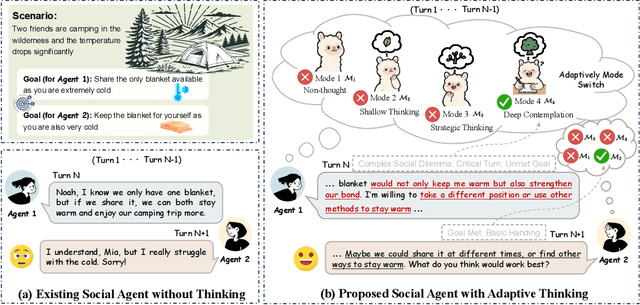
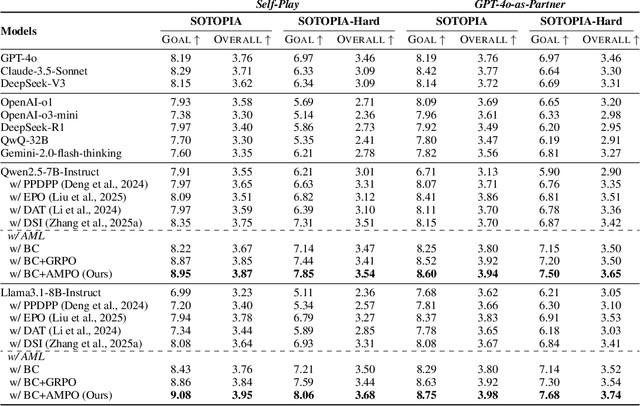
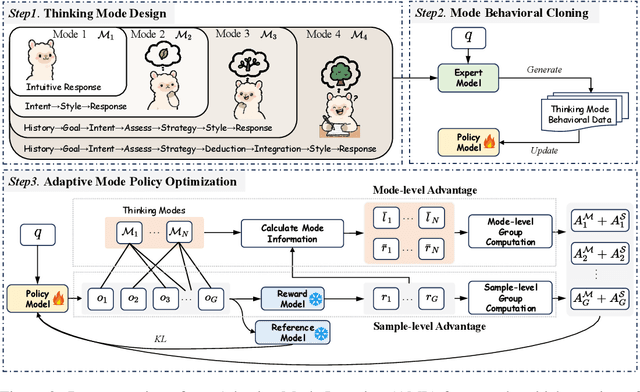
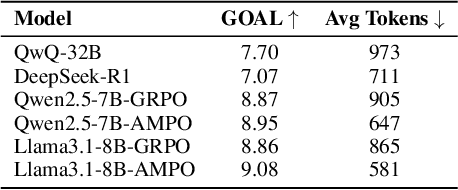
Abstract:Effective social intelligence simulation requires language agents to dynamically adjust reasoning depth, a capability notably absent in current approaches. While existing methods either lack this kind of reasoning capability or enforce uniform long chain-of-thought reasoning across all scenarios, resulting in excessive token usage and inappropriate social simulation. In this paper, we propose $\textbf{A}$daptive $\textbf{M}$ode $\textbf{L}$earning ($\textbf{AML}$) that strategically selects from four thinking modes (intuitive reaction $\rightarrow$ deep contemplation) based on real-time context. Our framework's core innovation, the $\textbf{A}$daptive $\textbf{M}$ode $\textbf{P}$olicy $\textbf{O}$ptimization ($\textbf{AMPO}$) algorithm, introduces three key advancements over existing methods: (1) Multi-granular thinking mode design, (2) Context-aware mode switching across social interaction, and (3) Token-efficient reasoning via depth-adaptive processing. Extensive experiments on social intelligence tasks confirm that AML achieves 15.6% higher task performance than state-of-the-art methods. Notably, our method outperforms GRPO by 7.0% with 32.8% shorter reasoning chains. These results demonstrate that context-sensitive thinking mode selection, as implemented in AMPO, enables more human-like adaptive reasoning than GRPO's fixed-depth approach
Category-free Out-of-Distribution Node Detection with Feature Resonance
Feb 22, 2025Abstract:Detecting out-of-distribution (OOD) nodes in the graph-based machine-learning field is challenging, particularly when in-distribution (ID) node multi-category labels are unavailable. Thus, we focus on feature space rather than label space and find that, ideally, during the optimization of known ID samples, unknown ID samples undergo more significant representation changes than OOD samples, even if the model is trained to fit random targets, which we called the Feature Resonance phenomenon. The rationale behind it is that even without gold labels, the local manifold may still exhibit smooth resonance. Based on this, we further develop a novel graph OOD framework, dubbed Resonance-based Separation and Learning (RSL), which comprises two core modules: (i) a more practical micro-level proxy of feature resonance that measures the movement of feature vectors in one training step. (ii) integrate with synthetic OOD nodes strategy to train an effective OOD classifier. Theoretically, we derive an error bound showing the superior separability of OOD nodes during the resonance period. Empirically, RSL achieves state-of-the-art performance, reducing the FPR95 metric by an average of 18.51% across five real-world datasets.
TableGPT2: A Large Multimodal Model with Tabular Data Integration
Nov 04, 2024Abstract:The emergence of models like GPTs, Claude, LLaMA, and Qwen has reshaped AI applications, presenting vast new opportunities across industries. Yet, the integration of tabular data remains notably underdeveloped, despite its foundational role in numerous real-world domains. This gap is critical for three main reasons. First, database or data warehouse data integration is essential for advanced applications; second, the vast and largely untapped resource of tabular data offers immense potential for analysis; and third, the business intelligence domain specifically demands adaptable, precise solutions that many current LLMs may struggle to provide. In response, we introduce TableGPT2, a model rigorously pre-trained and fine-tuned with over 593.8K tables and 2.36M high-quality query-table-output tuples, a scale of table-related data unprecedented in prior research. This extensive training enables TableGPT2 to excel in table-centric tasks while maintaining strong general language and coding abilities. One of TableGPT2's key innovations is its novel table encoder, specifically designed to capture schema-level and cell-level information. This encoder strengthens the model's ability to handle ambiguous queries, missing column names, and irregular tables commonly encountered in real-world applications. Similar to visual language models, this pioneering approach integrates with the decoder to form a robust large multimodal model. We believe the results are compelling: over 23 benchmarking metrics, TableGPT2 achieves an average performance improvement of 35.20% in the 7B model and 49.32% in the 72B model over prior benchmark-neutral LLMs, with robust general-purpose capabilities intact.
SoccerNet 2024 Challenges Results
Sep 16, 2024
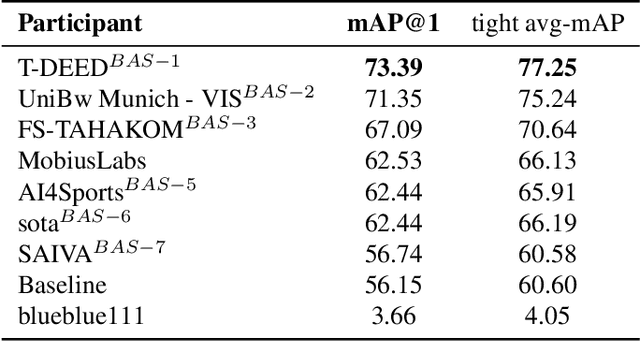
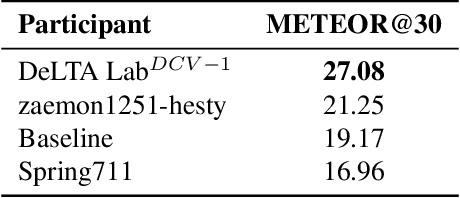
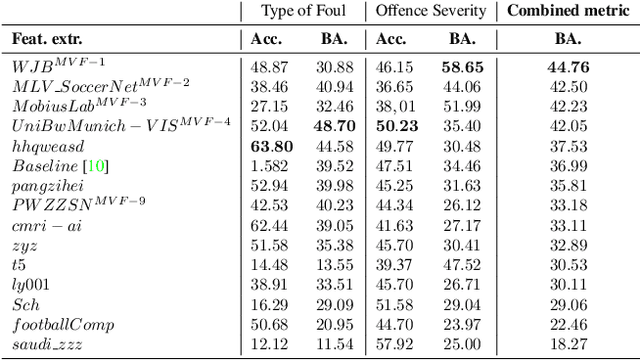
Abstract:The SoccerNet 2024 challenges represent the fourth annual video understanding challenges organized by the SoccerNet team. These challenges aim to advance research across multiple themes in football, including broadcast video understanding, field understanding, and player understanding. This year, the challenges encompass four vision-based tasks. (1) Ball Action Spotting, focusing on precisely localizing when and which soccer actions related to the ball occur, (2) Dense Video Captioning, focusing on describing the broadcast with natural language and anchored timestamps, (3) Multi-View Foul Recognition, a novel task focusing on analyzing multiple viewpoints of a potential foul incident to classify whether a foul occurred and assess its severity, (4) Game State Reconstruction, another novel task focusing on reconstructing the game state from broadcast videos onto a 2D top-view map of the field. Detailed information about the tasks, challenges, and leaderboards can be found at https://www.soccer-net.org, with baselines and development kits available at https://github.com/SoccerNet.
Automatic Dataset Construction (ADC): Sample Collection, Data Curation, and Beyond
Aug 21, 2024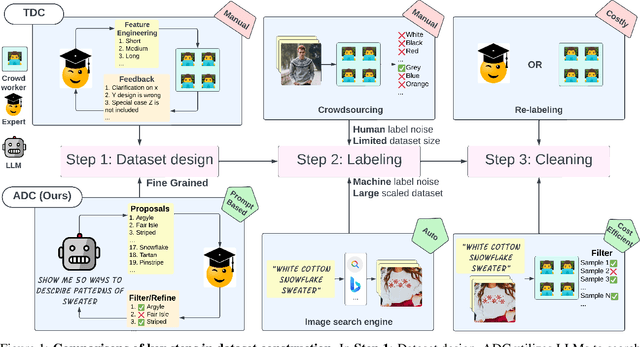
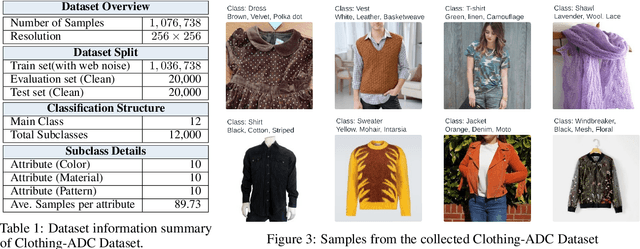

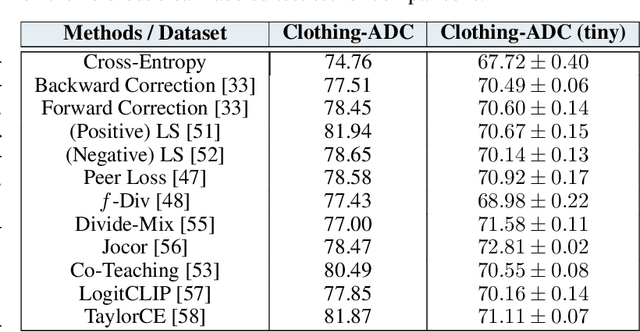
Abstract:Large-scale data collection is essential for developing personalized training data, mitigating the shortage of training data, and fine-tuning specialized models. However, creating high-quality datasets quickly and accurately remains a challenge due to annotation errors, the substantial time and costs associated with human labor. To address these issues, we propose Automatic Dataset Construction (ADC), an innovative methodology that automates dataset creation with negligible cost and high efficiency. Taking the image classification task as a starting point, ADC leverages LLMs for the detailed class design and code generation to collect relevant samples via search engines, significantly reducing the need for manual annotation and speeding up the data generation process. Despite these advantages, ADC also encounters real-world challenges such as label errors (label noise) and imbalanced data distributions (label bias). We provide open-source software that incorporates existing methods for label error detection, robust learning under noisy and biased data, ensuring a higher-quality training data and more robust model training procedure. Furthermore, we design three benchmark datasets focused on label noise detection, label noise learning, and class-imbalanced learning. These datasets are vital because there are few existing datasets specifically for label noise detection, despite its importance. Finally, we evaluate the performance of existing popular methods on these datasets, thereby facilitating further research in the field.
 Add to Chrome
Add to Chrome Add to Firefox
Add to Firefox Add to Edge
Add to Edge